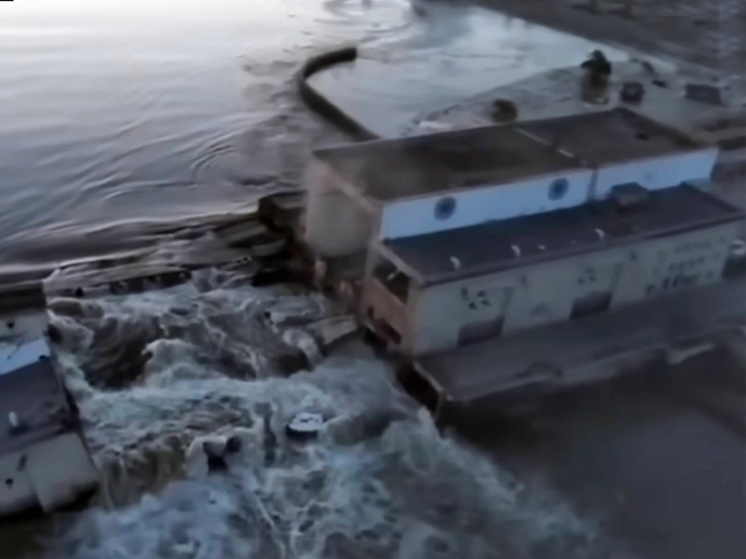«The peninsula can really be left without water again»
The destruction of the dam of the Kakhovskaya hydroelectric power station as a result of undermining by the Armed Forces of Ukraine can turn into a serious environmental disaster that will affect tens of thousands of people, cause illness, drought, crop failure. Russian ecologists come to this conclusion, even according to a preliminary assessment of what happened.

As a result of the huge release of water from the reservoir, the level of the Dnieper downstream rose on the day of the dam explosion, June 6, by 12 meters. The village of Korsunka turned out to be completely flooded; the roof flooded the city of Alyoshki, settlements: Dnepryan, Krynki, Cossack Camps; 80 percent flooded the city of Golaya Pristan. At least 7 people, shepherds grazing livestock, are missing, more than 1,000 have been evacuated and another 100 need to be evacuated. In total, 2.7 thousand houses were flooded on the Russian-controlled left-bank territory. In Novaya Kakhovka itself, up to a hundred people were blocked in their homes due to flooding.
According to data coming from the part of the Kherson region controlled by Ukraine, 1852 houses were flooded on the right bank of the Dnieper, about 1,500 residents were evacuated Kherson, who lived in the Korabel area.
According to the mayor of the city of Novaya Kakhovka (the administrative center of the Kakhovka district of the Kherson region) Vladimir Leontiev, it was possible to avoid major human casualties in the Kherson region only because the dam collapsed gradually.
By the morning of June 7, the water receded slightly from the settlements — its level in the river fell by half a meter. However, according to experts, the Kherson region has yet to experience the most serious consequences of the flood.
Comment by an ecologist and environmental specialist, Corresponding Member of the Russian Academy of Sciences, Deputy Director of the Institute of Geography of the Russian Academy of Sciences, Doctor of Geographical Sciences Arkady Tishkov:
I will single out five features of this flood. The first is the specificity of the reservoir itself. It is the last on the Dnieper, it occupies its lower reaches, the so-called Dnieper floodplains — densely populated, agricultural lands. Adaptation of the coastal zone, located below the HPP, provides for plus or minus 3 meters, depending on seasonal fluctuations.
However, on June 6, the water level here rose several times above the norm. Therefore, dozens of settlements fell into the flood zone: some went completely under water, others were flooded to the roof. Alas, the consequences of the disaster here will be very serious: the death of people, and water pollution, and the destruction of the infrastructure of the residential area and farmland.
The second feature, in terms of the degree of possible negative consequences, I would call a sharp drop in the water level in the reservoir itself. It will certainly affect the water supply and irrigation of lands in the region. Due to this reservoir, several canals were filled at once: the North Crimean, Dnepropetrovsk-Krivoy Rog, Verkhnerogachinsky and others. The total volume of water intake from it is about 900 cubic meters per second. Crimea can really be left without water again.
Third, the explosion of the Kakhovskaya HPP (provided that the dam itself is not destroyed) jeopardizes the possibility of full cooling of the Zaporizhzhya NPP reactors. In general, the nuclear power plant has its own, autonomous system of cooling pools and is not directly connected with the Kakhovka reservoir. But the general decrease in its level cannot but affect the state of the surface waters of the region, including alternative sources for the cooling pools of nuclear power plants.
Fourth, a catastrophic flood in a densely populated region and downstream will lead to chemical and biological pollution of the environment. Local and municipal sewerage, warehouses of chemical raw materials and fertilizers, waste disposal sites and household garbage will be washed away. This will definitely lead to a shortage of drinking water, outbreaks of diseases and a deterioration in the general sanitary and epidemiological situation in the region, especially in hot weather.
The fifth — the reservoir, and in general the Dnieper plavni — is a unique wetland of international importance. Everything that we see now takes place during the period of mass nesting of waterfowl. Some of them lose their nests due to flooding, others are deprived of feeding waters. Environmentally valuable lands and water areas are suffering.
Unregulated discharge of water in such volumes is always a disaster for the population, economy and nature both downstream and along the banks of a “losing weight” mostly shallow water body.
p>

